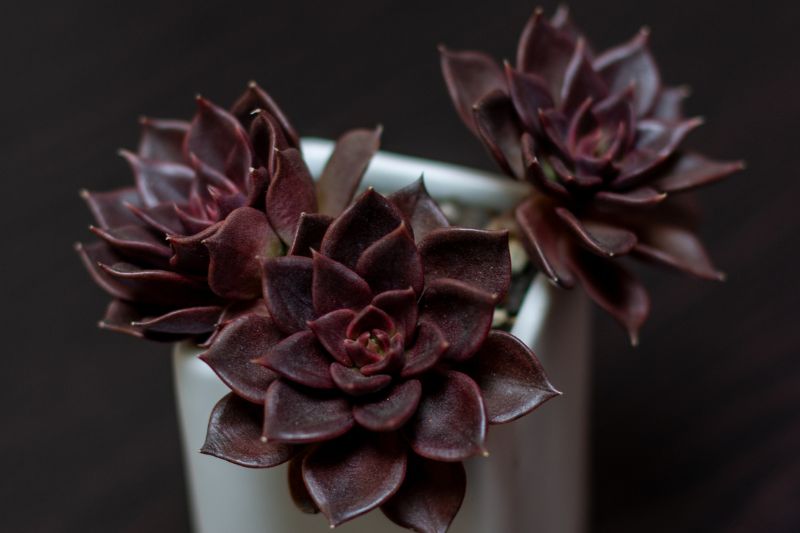Echeveria ‘Black Prince’ is a lovely hybrid succulent known for its dark foliage and beautiful flower display. Native to Mexico, this popular plant is a member of the Crassulaceae family and a popular choice among succulent enthusiasts due to its unique coloration and ease of care. It’s worth mentioning that there are several other houseplants with dark foliage that would make a great additions to any indoor garden.
Table of Contents
1. General Information & Taxonomy
| Scientific name: | Echeveria affinis ‘Black Prince’ |
| Common names: | Black Prince, Black Hens and Chicks |
| Native to: | Mexico |
| Category: | Succulent |
| Toxicity: | Non-toxic to humans and pets |
| Growth Rate: | Slow to moderate |
| Mature size: | Up to 6 inches (15 cm) tall and 8 inches (20 cm) in diameter |
| Hardiness: | USDA zones 9-11 |

2. Appearances And Flowering
- Leaves: Echeveria ‘Black Prince’ features rosettes of fleshy, triangular leaves that range from dark green to nearly black in color. The leaves have a smooth texture with a waxy coating, which helps protect the plant from water loss.
- Stem: This succulent has a short, stout stem that remains mostly hidden beneath the dense rosette of leaves.
- Flowers: Echeveria ‘Black Prince’ produces tall, arching flower stalks with bell-shaped, scarlet red flowers that bloom in the fall or early winter.
3. Echeveria ‘Black Prince’ Care & Growing Requirements
» Watering
Allow the soil to dry out completely between waterings. Overwatering can lead to root rot and other issues. It is generally recommended to water this plant every 7-10 days, depending on the climate and growing conditions.
» Light
This succulent prefers bright, indirect sunlight. Too much direct sunlight can cause the leaves to scorch or lose their dark coloration.
It can also tolerate partial to full sun, but it needs to be acclimated first.
» Soil and Potting Mix
Echeveria ‘Black Prince’ thrives in well-draining soil with a mixture of coarse sand, perlite, or pumice. A pre-made cactus or succulent potting mix is also suitable.
» Temperature and Humidity
This succulent prefers temperatures between 65°F and 80°F, but can tolerate brief periods of colder temperatures, as long as it is kept dry. Echeveria ‘Black Prince’ is not particularly humidity-sensitive but should be kept in a well-ventilated area to prevent fungal issues.
» Fertilizer
A balanced, water-soluble fertilizer can be applied during the active growing season (spring and summer) every 4-6 weeks. Do not fertilize during the dormant period (fall and winter).
4. How To Propagate Echeveria ‘Black Prince’
Echeveria ‘Black Prince’ can be propagated through various methods, such as leaf cuttings, offsets, stem cuttings, and seeds.
- Leaf cuttings: Gently remove a healthy leaf from the parent plant by twisting it off, making sure to get the entire base of the leaf. Allow the leaf to dry and callus over for a few days before placing it on well-draining soil. Do not bury the leaf, as this may cause it to rot. Mist the soil lightly and keep it slightly moist. Within a few weeks, you should see new roots and a tiny new plant forming at the base of the leaf.
- Offsets: Echeveria ‘Black Prince’ naturally produces offsets or “pups” around the base of the parent plant. Carefully remove the offsets with a clean, sharp knife, or by gently twisting them off. Allow the cuttings to callus for a few days before planting them in well-draining soil. Water sparingly until the new plants are established.
- Stem cuttings: If your Echeveria ‘Black Prince’ has a long, leggy stem, you can take a stem cutting to create a new plant. Cut a 3-4 inch (7-10 cm) section of stem with a clean, sharp knife. Remove the bottom leaves, leaving a few at the top of the cutting. Allow the cutting to callus for a few days before planting it in well-draining soil. Water sparingly until the cutting has rooted and established itself.
- Seeds: Echeveria ‘Black Prince’ can also be propagated from seeds, although this method is less common and may take longer to produce mature plants. Sow seeds on the surface of well-draining soil and mist lightly to keep the soil moist but not wet. Provide bright, indirect light and maintain temperatures between 65-75°F (18-24°C). Germination should occur within 2-4 weeks, after which you can transplant the seedlings into individual pots once they have developed a few sets of true leaves.
Final Thoughts
With its dark, nearly black foliage, beautiful scarlet red flowers, and low-maintenance care requirements, it is no wonder that this succulent has become a popular choice for both novice and experienced gardeners alike.
By following the care tips and propagation methods outlined in this article, you can ensure the success and longevity of your Echeveria ‘Black Prince’.






No Comments